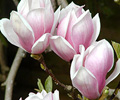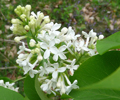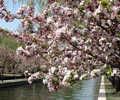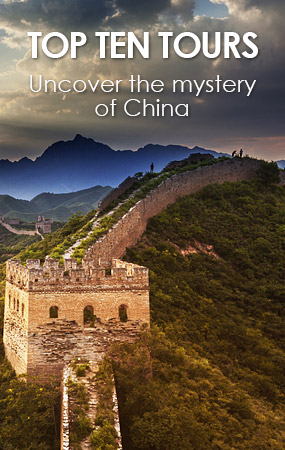Beijing Spring Flower
When you stand amid a sea of flowers in the parks or gardens, you will be aware that spring has come to every corner of Beijing. The whole city wakes up with flowers blooming here and there between late March and mid-May. Timing is everything when you search out the spring flowers. Beijing is an enchanting place to spend your spring when the flowers are in full bloom.
| Cherry Blossoms | Magnolia | Peach Blossom |
| Lilac | Peonies | The Chinese Flowering Crabapple |
| Tulips | Apricot Blossoms | Beijing Spring Flower Tour Tips |
Cherry Blossoms
Cherry blossom is Japan's national flower. In the early twentieth century, Japan started to present flowering cherry trees as gifts to other countries as symbols of goodwill.
In 1970s, 180 cherry trees were sent to China as gifts from Japan and were planted in Cherry Blossom Garden, northwest of Yuyuantan Park. As time passed more and more cherry trees were cultivated in the park and today Yuyuantan Park has become one of the largest parks in northern China. Every spring the Cherry Blossom Festival is held to show off the over 2,000 cherry trees made up of 20 species. It attracts many flower lovers as well as photographers from far and wide.
March and April are the best times to see the cherry blossoms. Cherry blossoms bloom for a very short time, just a week or two from flowering to withering.

Magnolia
Magnolia is the best-known flower species in Beijing. It can be seen in parks, gardens, along the streets, as well as the city’s many Buddhist temples.Temples are surrounded by mountain peaks that block the cold wind, creating a favorable warm and humid environment that has helped magnolia trees to thrive.
Among the many temples, Tanzhe Temple and Dajue Temple have long been famous for Magnolia. Magnolia is the symbol of Dajue temple. What's so special about the magnolia in Dajue Temple?
Dajue Temple
The magnolia tree in Siyitang Yard of Dajue Temple is said to be 300 years old, planted by a Buddhist monk named Jialing who lived in the Qing Dynasty (1644–-1911). It blossoms each year around early April. The magnolia flowers in Dajue Temple are exceptionally large, bright, elegant and fragrant. These eye-catching flowers surpass other magnolias in Beijing, drawing flocks of tourists each spring.
Visitors usually appreciate the flowers while sipping a cup of spring tea in the temple. The aroma of tea and flowers, combined with the beauty of ancient trees and historical sites, make Dajue Temple a peaceful and pure escape from city.

Tanzhe Temple
Tanzhe Temple has long been famous for its purple Magnolias. Most magnolias are white, but the two magnolia trees in Tanzhe Temple bear white and purple magnolias. The two magnolia trees are over 200 years old and are known to be second to none in the north of China. Locals call them the “Two Qiao Beauties”, after two famous beautiful women during the Three Kingdoms Period (220–280). The Magnolia blossoms between early and mid April, and lasts for only 10 days.

Beijing International Sculpture Park
The magnolia garden in the west of Beijing International Sculpture Park is a new place to view magnolia in Beijing. It has over 5,000 magnolia trees of nine varieties, with four different colors, including some that bear rare purple and yellow flowers. They have their longest blooming period from early April to mid-April.

Peach Blossom
Spring is the season of peach blossom. Peach trees can be found in many places in Beijing.
Beijing Botanical Garden, renowned as the largest botanical garden in North China, has thousands of peach trees of about 70 species, including the ornamental peach, wide peach and chrysanthemum peach. Peach blossom is in bloom from April to early May, during which time the Beijing Peach Blossom Festival will be held. The garden is impregnated with romantic blooms, intoxicating fragrance and vivid colors.

Lilac
Lilac, considered as a symbol of purity, is another flower that can be found in many of Beijing’s Buddhist temples. Three of the most popular are Jietai Temple, Fayuan Temple and the Temple of Heaven.
Jietai Temple
Jietai Temple boasts 1,000 lilac trees, among which 20 have an age of over 200 years. Legend has it that, during the Qing Dynasty (1644–1911), the emperor once visited Jietai Temple, and ordered the replanting of some lilac trees from the Old Summer Palace to Jietai Temple. Whenever the lilacs bloom, in mid and late April every year, the temple is impregnated with the fragrance of lilacs.

Fayuan Temple
Lilacs in Fayuan Temple include the purple and white native variety, as well as foreign ones reportedly brought from the Maluku Islands by Zheng He (1371–1435), a Ming-era voyager. The best time to view lilacs in Fayuan Temple is mid-April to late April, during which time you’ll be charmed by the sea of lilac.

The Temple of Heaven
The Temple of Heaven is another place to view lilacs. The Temple of Heaven boasts the largest tract of lilacs in the city. The area, measuring 6,300 square meters (69, 000 square feet), is located west of the Hall of Prayer for Good Harvest.

Peonies
The peony is called "Mudan" in Chinese, and is the national flower of China, known as the flower of riches and honor. It is used symbolically in Chinese art.
Jingshan Park is famous for peonies, and is the biggest peony rose garden in Beijing. Peonies have been planted in Jingshan Park since the Yuan Dynasty (1271–1368). The park has more than 1,000 peonies of some 100 varieties.
The best time for viewing peonies in Jingshan Park is from late April to mid-May.

The Chinese Flowering Crabapple
The Chinese flowering cCrabapple has been famous for its flowers, suiting both refined and popular tastes, since ancient times, and its blooms are called flower fairies and imperial flowers. It is a wild-and-confused-looking tree, but blooms brilliantly.
Yuan Dynasty City Wall Relics Park has the largest number of Chinese flowering crabapple trees in Beijing. The park holds a festival to coincide with the flower’s’ full blooming from mid April to late April, during which time thousands flock to the park to witness the 2,500 trees in full bloom.

Tulips
Tulips are often associated with the Netherlands. Tulips have three inner petals and three outer sepals that look much like petals and are one of the world's most easily recognized and loved flowers.
There are huge swathes of tulips planted throughout Zhongshan Park, lining its paths. 39 varieties of tulip were presented to the park in 1977 by the Princess of the Netherlands.
Late April to early May is the best time to witness the tulips in full bloom. In addition to the tulips, there are also many other varieties, such as wisteria, bamboo, and peonies. It really has to be seen if you are visiting Beijing during the spring.

Apricot Blossoms
In the north of China, Apricot trees are among the first to blossom. This is known as the herald of spring.
Every April, when apricots bloom, visitors swarm into Fenghuangling (Phoenix Ridge) Nature Park to enjoy the flowers. There are 40 hectares (99 acres) of apricots planted in the park. From the hillside to the valley, the mountain is covered with the pink and white flowers. As the mountain is huge, you never feel crowded when strolling among the flowers.

Beijing Spring Flower Tour Tips
Spring has a mild climate and favorable temperatures, which are agreeable for people going for a spring walk to enjoy the colorful flowers. However, there are things you should know in order to enjoy these delights.
1. Different species of flowers have their own blossoming times. Usually, the blossoming period of each species of flowers is about 10 days. Some may last shorter or longer due to topography and climate. You are advised to contact us before taking a spring flower tour so that we can check the best time.
2. Be cautious of pollen allergiesy, especially those people with histories of allergies and respiratory diseases.

